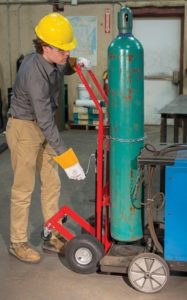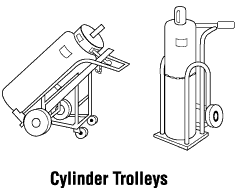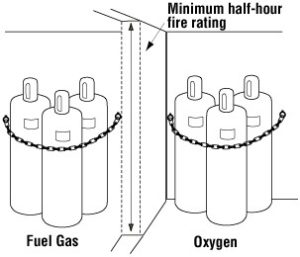July Safety Tip
Compressed Gas Safety
Compressed gases can be toxic, flammable, oxidizing, corrosive, or inert. In the event of a leak, inert gases can quickly displace air in a large area creating an oxygen-deficient atmosphere, toxic gases can create poisonous atmospheres, and flammable or reactive gases can result in fire and exploding cylinders. In addition, there are hazards from the pressure of the gas and the physical weight of the cylinder. A gas cylinder falling over can break containers and crush feet. The cylinder can itself become a missile if the cylinder valve is broken off.
Compressed gases can cause fires, explosions, oxygen deficient atmospheres, toxic gas exposures as well as the innate physical hazard associated with cylinders under high pressure. Special storage, use, handling and disposal procedures are necessary to ensure the safety of researchers using these chemicals and equipment.
General cylinder safety
- Accept only properly identified cylinders and do not rely on color codes.
- Wear safety equipment appropriate for the hazard potential of the gas before beginning work.
- If a cylinder or valve is noticeably corroded, the vendor should be contacted for instructions.
- A leaking cylinder should be removed and isolated in a well-ventilated safe area. It may be necessary to call in trained emergency response personnel.
- If the leak is at the junction of the cylinder valve and cylinder DO NOT try to repair! Instead, contact the supplier.
Storage, Use and Handling
- Properly secure cylinders in a well ventilated and protected area away from heat, flames, and the sun in an upright position and supported at all times, whether full or empty. Acceptable methods of support include:
- wall-mounted or bench-mounted gas cylinder brackets;
- chains or belts anchored to walls or benches; and,
- free-standing dollies or carts designed for gas cylinders and equipped with safety chains or belts.
- Segregate cylinders by hazard classes while in storage.
- Discontinue use of the cylinder when it has at least 25 psi remaining; close valve to prevent air and moisture from entering. Return unused and empty cylinders to the vendor for reuse or refill.
- Mark or tag empty cylinders “EMPTY”
- All compressed gas cylinders must bear labels that clearly identify the contents.
- Gas cylinders must have the valve protection cap in place except when in use.
- Use appropriate dollies or hand trucks to move cylinders weighing more than 50 pounds.
- Pressure regulators and gauges must be compatible with the cylinder valves. You may not use “cheaters” (adapters) instead of the correct regulator and gauge.
Remember:
- Never roll a cylinder to move it.
- Never carry a cylinder by the valve.
- Never leave an open cylinder unattended.
- Never leave a cylinder unsecured.
- Never force improper attachments on to the wrong cylinder.
- Never grease or oil the regulator, valve, or fittings of an oxygen cylinder.
- Never refill a cylinder.
- Never use a flame to locate gas leaks.
- Never attempt to mix gases in a cylinder.
- Never discard pressurized cylinders in the normal trash.
- DO NOT purchase more or larger cylinders than necessary;
- DO NOT use copper fittings or tubing on acetylene tanks;
- DO NOT use Teflon tape on cylinder or tube fitting connections, which have metal-to-metal face seals or gasket seals;
- DO NOT permit oil or grease to contact cylinders or their valves, especially cylinders containing oxidizing gases.
- Store oxygen cylinders and fuel gas cylinders separately. Indoors: separate oxygen from fuel gas cylinders by at least 6.1 m (20 ft), or by a wall at least 1.5 m (5 ft) high with a minimum half-hour fire resistance. (From: CSA W117.2-12 (R-2017) “Safety in welding, cutting and allied processes”. Local jurisdiction requirements may vary.)
- Cylinders must also be separated away from flammable and combustible liquids and from materials that easily ignite (such as wood, paper, oil, grease, etc.) by similar requirements as oxygen cylinders (6.1 m, or a fire wall at least 1.5 m high with ½ hr fire resistance).
https://ehs.unc.edu/chemical/compressed-gas/ and https://www.ccohs.ca/oshanswers/safety_haz/welding/storage.html



